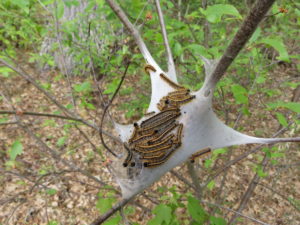Mike Hillstrom, forest health specialist, Fitchburg, Michael.Hillstrom@wisconsin.gov, 608-513-7690
Eastern tent caterpillars (ETC) are hatching and beginning to feed on host trees in Wisconsin, including cherry, apple and crabapple trees. Landowners and homeowners may notice the white silken tents forming in branch forks. Although the tents are unsightly, ETC is a native insect and rarely causes damage. Even completely defoliated trees will put out new leaves within a few weeks.

Eastern tent caterpillars preparing for a day of feeding on a black cherry tree.
If landowners are concerned by the appearance of tents in their yard trees and wish to remove them, it’s best to do so in the early morning or evening when the caterpillars are inside the tent. Unless it’s raining, eastern tent caterpillars leave their tents each morning to feed during the day before returning at night.
Caterpillars and their nests can be removed either by hand if they are within reach or with a rake if they are high in the tree. They can then be killed by soaking them in soapy water or sealing them in a trash bag. Insecticides are rarely necessary but need to penetrate inside the tent if used. Do not prune branches, burn tents or soak them with WD-40. These methods are more harmful to the tree than ETC defoliation and are not recommended.
For more information on eastern tent caterpillar, read this factsheet from UW-Madison Division of Extension.
